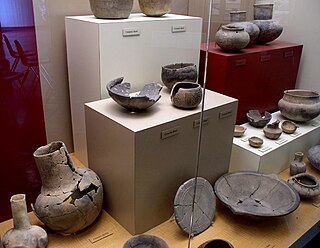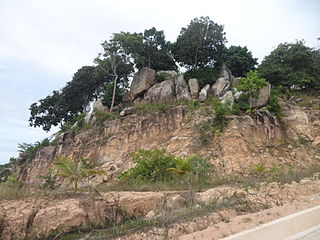
Processual archaeology is a form of archaeological theory that had its beginnings in 1958 with the work of Gordon Willey and Philip Phillips, Method and Theory in American Archaeology, in which the pair stated that "American archaeology is anthropology, or it is nothing", a rephrasing of Frederic William Maitland's comment: "My own belief is that by and by, anthropology will have the choice between being history, and being nothing." The idea implied that the goals of archaeology were, in fact, the goals of anthropology, which were to answer questions about humans and human culture. That was a critique of the former period in archaeology, the cultural-history phase in which archaeologists thought that any information that artifacts contained about past people and past ways of life would be lost once the items became included in the archaeological record. All they felt could be done was to catalogue, describe, and create timelines based on the artifacts.

Colluvium is a general name for loose, unconsolidated sediments that have been deposited at the base of hillslopes by either rainwash, sheetwash, slow continuous downslope creep, or a variable combination of these processes. Colluvium is typically composed of a heterogeneous range of rock types and sediments ranging from silt to rock fragments of various sizes. This term is also used to specifically refer to sediment deposited at the base of a hillslope by unconcentrated surface runoff or sheet erosion.
Gordon Randolph Willey was an American archaeologist who was described by colleagues as the "dean" of New World archaeology. Willey performed fieldwork at excavations in South America, Central America and the Southeastern United States; and pioneered the development and methodology for settlement patterns theories. He worked as an anthropologist for the Smithsonian Institution and as a professor at Harvard University.

James Bennett Griffin or Jimmy Griffin was an American archaeologist. He is regarded as one of the most influential archaeologists in North America in the 20th century.

Jane Ellen Buikstra is an American anthropologist and bioarchaeologist. Her 1977 article on the biological dimensions of archaeology coined and defined the field of bioarchaeology in the US as the application of biological anthropological methods to the study of archaeological problems. Throughout her career, she has authored over 20 books and 150 articles. Buikstra's current research focuses on an analysis of the Phaleron cemetery near Athens, Greece.

The Grand Village of the Illinois, also called Old Kaskaskia Village, is a site significant for being the best documented historic Native American village in the Illinois River valley. It was a large agricultural and trading village of Native Americans of the Illinois confederacy, located on the north bank of the Illinois River near the present town of Utica, Illinois. French explorers Louis Joliet and Father Jacques Marquette came across it in 1673. The Kaskaskia, a tribe of the Illiniwek people lived in the village. It grew rapidly after a French mission and fur trading post were established there in 1675, to a population of about 6,000 people in about 460 houses. Around 1691 the Kaskaskia and other Illiniwek moved further south, abandoning the site due to pressure from an Iroquois invasion from the northeast.
The Center for American Archeology, or CAA, is an independent non-profit 501(c)(3) research and education institution located in Kampsville, Illinois, USA, near the Illinois River. It is dedicated to the exploration of the culture of prehistoric Native Americans and, to a lesser extent, the European settlers who supplanted them.

The Koster Site is a prehistoric archaeological site located south of Eldred, Illinois. The site covers more than 3 acres and extends 30 feet down into the alluvial deposits of the Illinois River valley. Over the course of its excavation between 1969 and 1978, Koster produced deeply buried evidence of ancient human occupation from the early Archaic period to the Mississippian period. The soil strata contains a total of 25 distinct occupations each separated by additional layers of soil, making the site exceptionally well-preserved.
Gregory Herman Perino was an American self-taught professional archaeologist, author, consultant, and the last living founder of the Illinois State Archaeological Society. Perino was considered one of the foremost experts on Native American artifacts. He died July 4, 2005, at the age of 91.

The Upper Mississippian cultures were located in the Upper Mississippi basin and Great Lakes region of the American Midwest. They were in existence from approximately A.D. 1000 until the Protohistoric and early Historic periods.

Martha Hopkins Struever (1931–2017) was an American Indian art dealer, author, and leading scholar on historic and contemporary Pueblo Indian pottery and Pueblo and Navajo Indian jewelry. In June 2015, a new gallery in the Wheelwright Museum of the American Indian, was named for her. The first permanent museum gallery devoted to Native American jewelry, the Martha Hopkins Struever Gallery, is part of the Center for the Study of Southwestern Jewelry.

Crow Canyon Archaeological Center is a 170-acre (69 ha) research center and "living classroom" located in southwestern Colorado, US, which offers experiential education programs for students and adults.

Jeremy "Jerry" Arac Sabloff is an American anthropologist and past president of the Santa Fe Institute. Sabloff is an expert on ancient Maya civilization and pre-industrial urbanism. His academic interests have included settlement pattern studies, archaeological theory and method, the history of archaeology, the relevance of archaeology in the modern world, complexity theory, and trans-disciplinary science.
There are many sites within the Midwestern United States. Some of the better known sites are the Koster Site in Illinois, the Green River Valley in Kentucky, Hendricks Cave in Ohio, Indian Knolls and Dravo Gravel.
The Huber Site (11Ck-1) is located on Tinley Creek 2 miles west of Blue Island in Cook County, Illinois, near the city of Chicago. It is classified as a late prehistoric site with Upper Mississippian affiliation.
The Hoxie Farm site (11Ck-4) is located on Thorn Creek in Thornton, Illinois Cook County Forest Preserve in Cook County, Illinois, near the city of Chicago. It is classified as a late prehistoric to Protohistoric/Early Historic site with Upper Mississippian Huber affiliation.
The Oak Forest Site (11Ck-53) is located in Oak Forest, Cook County, Illinois, near the city of Chicago. It is classified as a late prehistoric to Protohistoric/Early Historic site with Upper Mississippian Huber affiliation.
The Anker Site (11Ck-21) is located on the Little Calumet River near Chicago, Illinois. It is classified as a late prehistoric site with Upper Mississippian Huber affiliation.

William D. Lipe, also known as Bill Lipe, is an archaeologist known for his work in the American Southwest and his Conservation Model. Lipe has contributed to Cultural Resource Management (CRM) and public archaeology. In addition to this, he has done work with the Glen Canyon Project, the Dolores Archaeological Program, and the Crow Canyon Archaeological Center.











